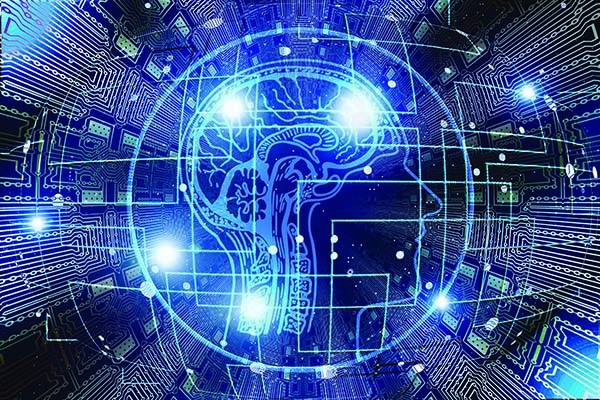Advanced technology now makes it possible for computers to do many of the monitoring and diagnostic tasks that used to require seasoned experts. Artificial intelligence and machine learning tools are being used to optimize assets, improve safety and security, create new business models, and maximize human resources.
The U.S. government calls the effort to modernize the vast but aging national electricity delivery system–the transformation to a smart grid–"an unprecedented opportunity to move the energy industry into a new era of reliability, availability, and efficiency." As much as the decade-old effort is focused on transmission, distribution, and the end-user, for the smart grid to fulfill its promise in the U.S., the upstream segment of the grid has to get smarter too, by investing in the digital technologies needed to become an intelligent enterprise.
The Digital Revolution
The push to optimize and innovate using digital tools such as artificial intelligence (Figure 1), machine learning, and predictive analytics isn't just good business, it's a strategic imperative in a power market where every little bit of business intelligence, every extra piece of timely, data-informed insight, can strengthen a power producer's competitive foothold and solidify customer relationships. The U.S. electricity industry will spend a projected $3.5 billion annually, and a total of $46 billion through 2030, according to an April 2018 federal government report authored by energy policy specialist Richard J. Campbell, to continue to modernize the grid through investments in digital communications technology, information systems, and automation in an effort to accommodate more complex power flows and to improve overall reliability, efficiency, and safety, while also meeting future demand from new uses. The roughly 9,200 electric generating units and more than 1,000,000 MW of generating capacity that feed the U.S. electric grid likely will account for a sizable chunk of that investment.
To keep pace in a smarter energy world, power generation operations must become more intelligent. Digital enablement provides the most direct route to get there. Today, here in North America as well as abroad in places like Europe (the countries of Western Europe, led by the likes of Italy, Sweden, France, and the UK, plan to invest $133.7 billion in smart grid infrastructure by 2027, according to a recent study by the Northeast Group), progressive energy utilities and power producers are remaking themselves into "intelligent enterprises." But they are not alone. Utilities and power producers in places like Dubai, India, and Australia are optimizing their operations–and creating new opportunities for themselves–by embracing enterprise-wide digital business practices too.
What is an intelligent enterprise, exactly? Among power generators, it's a data-savvy, cloud-enabled enterprise in which decisions in all areas of the business are informed by fresh streams of data and connected by a single digital platform that in turn is linked to the broader power grid. To that platform are connected the massive data-gathering capabilities of the Internet of Things (IoT), and specifically, sensor-equipped infrastructure and equipment that feed the digital system with fresh data, sourced not only from a power producer's own generation network, but also from relevant points across the power grid. Also linked to that digital platform are tools such as artificial intelligence (AI), machine learning, and predictive analytics that enable an organization to analyze, learn from, and act upon all that data, and to do so faster and more cost-effectively.
Investing in the Future
The business case for moving to an intelligent power generation enterprise is becoming clearer as some of the more aggressive technology adopters begin to realize substantial returns on their digital and IoT investments. The following are a handful of areas where well-directed investments to build a digitally intelligent enterprise can pay quick dividends.
Optimization of Assets. By giving power companies the ability to monitor and act upon developments across the grid and within their own systems in real time, digital solutions can help power producers gain efficiency across multiple facets of their operations, from preventive plant maintenance to fuel use decisions and beyond. By outfitting power generation facilities and equipment with sensors, power companies aren't just producing megawatts, they're creating megabyte upon megabyte of data. The right digital tools can turn a huge volume of data into an inexhaustible strategic resource.
For example, an AI-equipped digital platform can become the "brain" of a power production operation, drawing from deep-learning algorithms to instantly analyze real-time data, spot patterns and anomalies in datasets, then make on-the-spot decisions to optimize generation efficiency with real-time adjustments across assets.
Distributed generation is here to stay, complicating supply and demand forces. When private users generate their own electricity from renewable sources such as wind and solar, utility companies need efficient ways to assimilate that excess energy into the grid. AI can help them manage their generation assets more efficiently, reliably, and flexibly in response to supply and demand fluctuations from distributed generation. These same AI and machine learning tools can also help power companies make sounder, faster, data-driven decisions about when to operate peaker plants to meet spikes in demand, and where to route power around problem areas.
Maintenance is another area where digitalization can lead to optimization. Power generators are developing algorithms based on industry intelligence that predict the probability of failure. These algorithms take into account industry-wide early failure rates for equipment, creating a richer understanding of premature failure risks for enhanced asset maintenance, workflow, and portfolio management. Instead of relying on time-intensive and risky manual inspections, power companies can use autonomous robots and drones trained on these deep-learning algorithms, along with sensors, to automatically identify defects and predict failures without interrupting operations. The failure of a key component can cause a cascade of power failures. A digitally intelligent power production operation can keep that from happening, avoiding costly equipment failures and keeping a generation plant running in a business where uptime is critical to maintaining profitability.
Digital tools can also speed up system repairs. By relying on data from remote sensors, power producers can pinpoint where to send a crew for a repair, and based on an assessment of the damage, ensure the team arrives with the right tools for the job. Say a power company, through sensor monitoring, is alerted that a turbine is showing signs of failure. The utility can shut down the turbine proactively, before it fails, then send technicians to service it. Not only does the company dodge the expense of replacing the turbine, it avoids an unplanned service disruption–and the customer dissatisfaction that accompanies it.
Digital twin–the process by which data from sensors, computers, and equipment connected to the Internet of Things are used to create a virtual representation of a physical asset or process–is a powerful tool that can boost the efficiency of a power generation operation. The digital twin serves as a platform for modeling existing physical systems in the digital realm, so a company can run different scenarios to determine certain outcomes, then make appropriate changes to the real-life environment or system. Power producers thus can use a digital twin in tandem with predictive tools to foresee maintenance issues, equipment failures, and the like, and also for training personnel to operate, repair, and maintain equipment.
Safety and Security. By relying less on human beings and more on sensors, autonomous robots, and drones to inspect and even repair equipment, power producers can dramatically improve worker safety and insulate themselves from human error. Instead of having to conduct visual inspections by a human expert, they can conduct in-depth inspections from the comfort of an office. And when a failure or other equipment issue does arise, rather than first sending personnel out to investigate, subjecting them to risk of fire, steam exposure, explosion, and more, they can initially gauge the nature of the problem and the hazard remotely using sensors and robots or drones, then decide how to proceed.
Predictive analytics tools and digital twin technology can also help a power provider develop safer strategies to maintain and repair generation assets in inhospitable or difficult-to-access areas.
Security is another area of vulnerability that digital technology can address. The potential for a major disruption or widespread damage to the nation's power system from a cyberattack has increased focus on the cybersecurity of the smart grid. When a power production enterprise can rely on a digital platform that is protected by AI- and machine learning-enabled security systems, its physical infrastructure, its cyber structure (including software and communications), and its data become less susceptible to cyberattack.
New Business Opportunities. With the rise of distributed power, the era of the virtual power plant (VPP) is upon us. These cloud-based, central or distributed hubs aggregate, optimize, and control distributed energy resources to behave similarly to conventional dispatchable power plants, only they deliver power without a physical plant.
For their ability to increase the overall efficiency, flexibility, and reliability of the electricity grid, VPPs also represent a promising new growth opportunity for power companies. A power producer that already has a data-powered digital platform equipped with AI, machine learning, and other tools has the means to explore and develop VPP opportunities without a major new capital outlay.
Maximize Human Resources. Anyone who has followed the story of the Vogtle nuclear construction project in Georgia, and the inability of its majority owner, Georgia Power, to attract skilled labor to the site to complete the already delayed expansion project knows how much the talent squeeze is impacting the utility and power generation sectors. Because they automate tasks once handled by humans, digital tools enable power producers to run leaner, with less reliance on humans.
 |
|
2. Getting creative. When machines take on monotonous chores, workers are free to focus on solving problems and adding value to the organization. Source: Pixabay |
Once freed from mundane tasks, employees can be deployed to more engaging, higher-value pursuits (Figure 2). During a time in which energy companies are hard-pressed to recruit and retain quality talent, this can make working for a power company more appealing. The challenge of helping to develop the smart grid or a virtual power plant business using AI, digital twin, and predictive tools could hold much more appeal than a job whose main function is monitoring instruments and data streams for 40 hours a week.
The digitally powered intelligent enterprise opens a wide range of promising possibilities for power generators. Early evidence suggests that tools like AI can deliver real value to serious adopters. With the continuing maturation of the smart grid, now is the time to implement these tools. ■
–James McClelland is senior global marketing director of SAP's energy & utility industry vertical.

